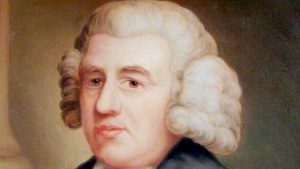
John Newton (1725 – 1807)
John Newton lived in Olney for nearly 16 years (1764 to 1779) as curate-in-charge of the parish church, St Peter & St Paul.
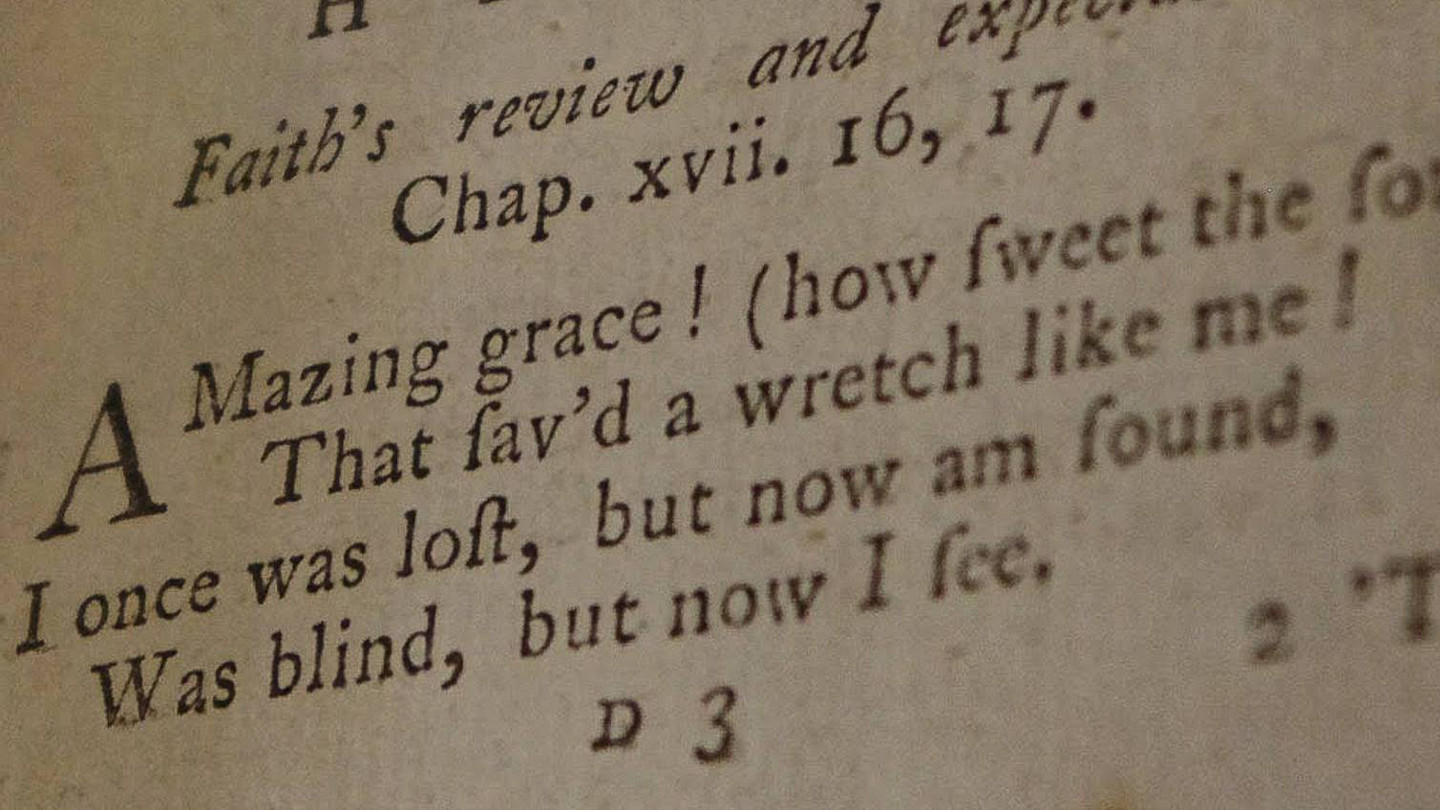
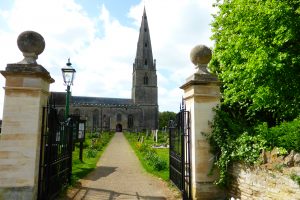
Discover more about Amazing Grace and the Olney Hymns in our new virtual exhibition
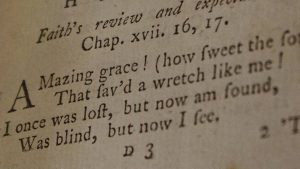
It is highly likely that the hymn, ‘Faith’s Review and Expectation’ (Amazing Grace’), was written by John in the weeks leading up to his New Year’s Day service on 1st January 1773.
The evidence for this comes from research carried out by the John Newton Project and evidence from John Newton’s sermon notebook in Lambeth Palace Library, the first edition of the ‘Olney Hymns’ as well as John’s diary which includes entries for January 1773 held by Princeton University Library.
John was at home in Olney during this time so the hymn was probably written in the top floor attic study of his Vicarage.
Tuesday 22 December 1772
‘Employed variously, sometimes composing hymns – visiting the people etc.’
The Morgan Museum and Library, John Newton Diary covering 1756 -1772
1st January 1773
‘ I preached this Forenoon from 1 Chron. 17,16,17′
Princeton University Library, John Newton Diary
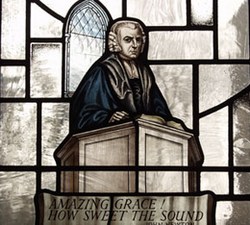
For his 1773 New Year Day morning service, John preached his sermon based on 1 Chronicles 17 v 16, 17, an ideal subject for New Year’s Day. As with his hymns, John often used examples from his own life to help his congregation of lace makers, farmworkers, tradespeople, young people etc understand his message. As David is encouraged to do in this passage, John talked about looking back at life and considering who you are now, as well as looking forward to what the future might hold.
‘Through many dangers, toils and snares,
I have already come’
The verses of the hymn Faith’s Review and Expectation, now known as Amazing Grace, were also based on 1 Chronicles 17 v 16, 17. They resonate with John’s own personal history as a recalcitrant young sailor in the shipping trade & Navy, as well as his later participation in the transatlantic slave trade. They also remind us of a day that John never forgot throughout his life when on 21st March 1748 aboard a badly stormed-damaged trading ship and fearing for his life he began his journey back to his faith:
‘Amazing grace! (how sweet the sound)
That sav’d a wretch like me!’
Jonathan Aiken in his book ‘Disgrace to Amazing Grace’ also suggests that John might have been looking to support his friend William Cowper who was again slipping into deep depression.
‘Tis grace has brought me safe thus far,
And grace will lead me home.’
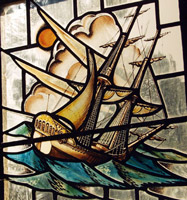
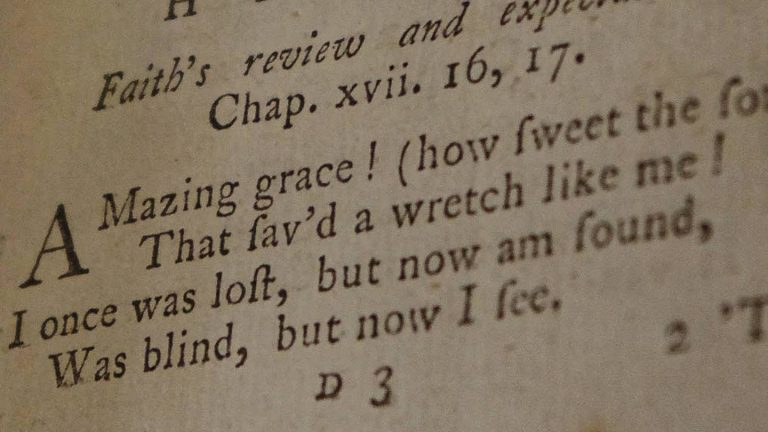
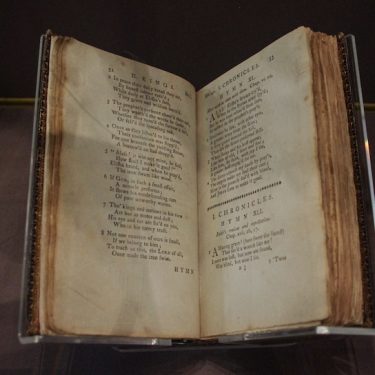
John hoped to preach without reading from a written prepared sermon, but early on he found he froze. His practice became to write his thoughts out in notebooks prior to giving his sermon.
‘Before I made the essay, I had expected to preach extempore but though I use no notes in the pulpit, I have found considerable advantage from writing my subjects beforehand; this takes up some of my mornings,..’
Letter to Lord Dartmouth 1765
The Museum owns several of John’s notebooks but the ‘Amazing Grace’ sermon notes (right) are in the Lambeth Palace Library.
”New Year’s Morning
1 Chron 17, 16,17
1. CHRONICLES
HYMN XLI
Faith’s review and expectation
Chap. xvii. 16,17.
Amazing grace! (how sweet the sound)
That sav’d a wretch like me!
I once was lost, but now am found,
Was blind, but now I see.
‘Twas grace that taught my heart to fear,
And grace my fears reliev’d;
How precious did that grace appear,
The hour I first believ’d!
Thro’ many dangers, toils and snares,
I have already come;
‘Tis grace has brought me safe thus far,
And grace will lead me home.
The Lord has promis’d good to me,
His word my hope secures;
He will my shield and portion be,
As long as life endures.
Yes, when this flesh and heart shall fail
And mortal life shall cease;
I shall possess, within the vail,
A life of joy and peace.
The earth shall soon dissolve like snow,
The sun forbear to shine;
But God, who call’d me here below,
Will be for ever mine.
Original words and verses from the 1st edition of the Olney Hymns, 1779, Book 1, Hymn 41
A facsimile copy of the first edition of the Olney Hymns can be purchased at the Museum or via our online shop
We don’t know for sure but The John Newton Project has also carried out research into possible tunes of the day. Visit the John Newton project website to listen to the English Chamber Choir singing ‘Amazing Grace’ to some of these tunes.
The ‘Amazing Grace’ Room at the Museum also tracks the development of the tune ‘New Britain’, the tune to which the hymn is most often sung today.
There is more information about the text development and the tune New Britain on this external website, Hymnology Archive.
We have some evidence of tunes for some of the Olney Hymns – Find out more and hear one of the hymns sung n our article to which are added hymns &ct
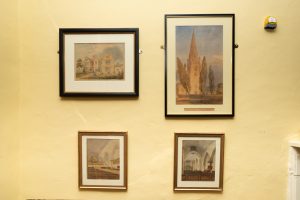 There is debate as to how soon after William came to live in Olney in 1767 that the idea of publishing a collection of hymns was taken. John was already singing hymns with his congregation in group meetings at the Vicarage, Lord Dartmouth’s unoccupied Great House or in the Church, and in some services in church.
There is debate as to how soon after William came to live in Olney in 1767 that the idea of publishing a collection of hymns was taken. John was already singing hymns with his congregation in group meetings at the Vicarage, Lord Dartmouth’s unoccupied Great House or in the Church, and in some services in church.
Find our more about John’s church of St Peter & St Paul in Olney in this article.
Back on the 1st January 1765, John had described to his patron Lord Dartmouth his plans for developing his groups:
‘I propose to establish three meetings … One for the children, another for the young and enquiring persons, and a third to be a meeting with the more experienced and judicious for prayer and conference.’
The meetings become so popular that there was not enough room in the Vicarage to hold all those who wanted to attend. In 1768 John was writing to Lord Dartmouth to say:
‘… we are so crowded that when the weather grows warmer we shall not be able to meet there without being greatly incommoded.’
John then went on to propose making use of ‘the large room in the great house on the right hand side; ..’ One of the rooms was already used to hold Sunday meetings, and for catechism with the children.
These meetings would often be a combination of prayer, engagement with the Bible and hymn singing (the children were often taught them by rote)
‘Oh for a closer Walk with God
A calm & heav’nly Frame,
A Light to shine upon the Road
That leads me to the Lamb!’
The Illustrated Timeline on the American Library of Congress website gives a fascinating overview of how the 18th century English hymn became one of the best known hymns in America. Here you will be able to see and hear how the hymn evolved with information, images and sound recordings from the online catalog of the Chasanoff/Elozua Amazing Grace Collection which includes more than 3,000 published recorded performances of the hymn.
The Amazing Grace @ 250 Personal Reflection virtual collection explores the role the hymn has played in people’s lives.

John Newton lived in Olney for nearly 16 years (1764 to 1779) as curate-in-charge of the parish church, St Peter & St Paul.
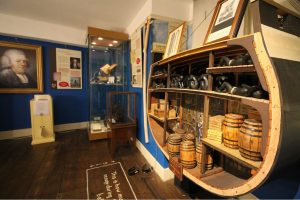
Charting John Newton’s childhood, experiences at sea, participation in the slave trade & courtship of Polly. Explore how a storm at sea affected his life & his journey from slave ship captain to abolitionist.
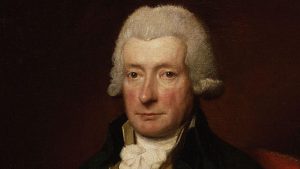
William Cowper (1731-1800), pronounced “Cooper”, was a renowned 18th century poet and translator of Homer. His most famous works include his 5000-line poem ‘The Task’ and some charming and light-hearted verses, not least ‘The Diverting History of John Gilpin’. Phrases he coined such as ‘Variety is the spice of life’ are still in popular use
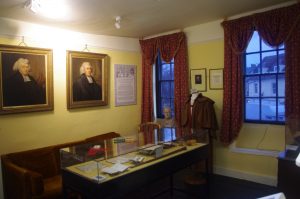
A new room dedicated to John Newton’s life in Olney as curate of St Peter & St Paul. With his friend Cowper, they wrote hymns for the people of Olney – the most famous today being ‘Amazing Grace’
Receive our latest news and updates delivered straight to your inbox
Museum and Gardens - £10.00 (includes an annual pass)
Gardens only - £4
Children under 16 - FREE
Hours: 11.00 - 4.30 (last entry 3.30)
Days: Tuesday, Wednesday, Thursday, Friday and Saturday
Open 29th March 2024 on Good Friday
Last opening day of this season is Wednesday 18th December 2024
The Olney Hymns
The hymns written by Cowper and Newton may have been first sung at Newton’s meetings in the Great House. Two hymns, Cowper’s ‘Jesus, Where’er Thy People Meet’ and Newton’s ‘On Opening a Place for Social Prayer’ were written for the move of the Tuesday prayer meeting for adults into the largest room in the Great House in 1769.
Some of the hymns had been published in other publications before 1779. Amongst these were:
Oh! for a closer walk with God
God moves in a mysterious way
Safely through another week
Encouraged by thy word
‘Copies of a few of these Hymns have already appeared in periodical publications, and in some recent collections. I have observed one or two of them attributed to persons who certainly had no concern in them, but as transcribers. All that have been at different times parted with in manuscript are included in the present volume; and (if the information were of any great importance) the public may be assured, that the whole number were composed by two persons only.’
We only have a little information about the tunes to which the hymns were originally sung. To which are added hymns &c
An Authentic Narrative
An Authentic Narrative began in 1762 as eight letters to Benjamin Fawcett, a Presbyterian minister at Kidderminster, who had asked Newton to write down more about his eventful life.
Newton’s letters were then seen by an evangelical clergyman Rev Thomas Haweis. He saw their potential as a spiritual narrative for general readers and asked Newton to add more detail, which extended the number of letters to 14. Haweis arranged their publication. Newton’s name did not appear but he was soon known to be the author.
The book brought him to the notice of potential patrons, including Lord Dartmouth, who helped him secure ordination and appointed him to his first parish in Olney.
Model of a slave ship in cross-section, showing how enslaved people were transported to the Americas.
During his seafaring career John Newton had no scruples about the lawfulness of the slave trade.
From the 17th century onwards the demand for slave labour to work in the American colonies grew. Slavery had existed in Africa long before the Europeans arrived, but to satisfy demand traders searched far inland, devastating communities.
By the 18th century Britain, of all the European countries, was the most active in the trade. It is said that between 1640 and 1807, the year the British Parliament passed the Bill to abolish slave trading by British subjects, British ships had transported as many as 3.4 million Africans across the Atlantic.
Newton’s letter to his wife, written at sea
When Newton transcribed this letter for publication in Letters to a Wife, published in 1793 after Mary’s death, he omitted his mention of the slaves. Elsewhere in the book he describes his involvement in this ‘vile trade’.
“I felt the disagreeableness of the business very strongly. The office of a gaoler, and the restraints under which I was forced to keep my prisoners, were not suitable to my feelings; but I considered it as the line of life which God, in his providence had allotted me, and as a cross which I ought to bear with patience and thankfulness till he should be pleased to deliver me from it. Till then, I only thought myself bound to treat the slaves under my care with gentleness, and to consult their ease and convenience so far as was consistent with the safety of the whole family of whites and blacks on board my ship.”
Newton’s letter to his wife, written at sea, page 2
In Liverpool, as Newton was preparing a new ship, the Bee, to sail on the next slave trading journey, he suffered a seizure which forced him to look for work on land.
His next job was as Tide Surveyor in the Port of Liverpool, applying customs rules to incoming ships. The role left him time for self-education and his first attempts at preaching.
View of Olney Church, with Great House and Mill
It took Newton ten years after he retired from life at sea to be ordained as a Church of England minister. Ordination was difficult for anyone to achieve without a university degree.
In preparation for ordination Newton read and studied extensively, but his known connections to Rev John Wesley, Rev George Whitefield and other Gospel and Non-conformist ministers would not have helped his case. Mary’s family helped dissuade him from taking a post outside the established Church of England.
Market Place, Olney
Three years after the Newton’s arrived, William Cowper, Mrs Mary Unwin and her daughter moved into the handsome house on the centre right of the picture, now the Cowper & Newton Museum.
This was the beginning of a long acquaintance between the two men which resulted in the compilation of the Olney Hymns.
In 1796, a survey of the Market Place notes, ‘The Dwellings comprized in No 13 (the Market Place) are very old, they stand in the middle of Olney Street, and are rather a nuisance.’ These building included the town Lock Up (seen in the painting) and the Shiel Hall in which on the top floor a school was run.
‘The Town of Olney has a long Street of above half a Mile: at the Bottom stand the Church. The Market, which is on a Monday, is kept about the Middle of the Street, on a sort of a Square, there are good Shambles, but no Market House. The Fairs are on Easter Monday & St Peter’s Day June 29.’ Rev William Cole of Bletchley (1714 – 1782)
John Newton’s Writing Desk
When the Newtons moved from Olney to the City of London at the end of 1779, his furniture was put up for sale. This was more practical than depending on horse and cart to transport large items over long distances.
The desk appears in a later sale of household goods as having been John Newton’s, and on the reverse of the sliding writing panel is a handwritten note confirming his ownership
Amazing Grace, from the first edition of the Olney Hymns
The idea of writing a hymn to prepare an audience for a sermon was something Newton did regularly. The hymn’s original title was Faith’s Review and Expectation.
Through the 18th and 19th century, Amazing Grace was printed separately in some hymn compilations in England and Scotland, including, ‘A Select Collection of Hymns Universally Sung in all the Countess of Huntingdon’s Chapels. (1780)’ and ‘A Collection of Hymns for the use of the Protestant Church of the United Brethren’ (1789).
Its later fame though was owed to its popularity in America. The hymn was first published in New York in 1790 and became particularly popular at Christian revival meetings.
Church of St Mary Woolnoth, City of London
Newton quickly established himself as a popular gospel preacher and, as in Olney, the congregation of St Mary Woolnoth grew rapidly.
He also gave spiritual talks in the houses of influential Londoners, and continued the publication of his pastoral letters. In 1781 he published Cardiphonia, letters to prominent people in evangelical circles in London. The book was widely read.
Thoughts upon the African Slave Trade, John Newton, 1788
Newton’s identified written contribution to the abolition movement came about relatively late in his life. His involvement in the slave trade was not a topic he published in writing until the 1780s.
It is likely that he did discuss the slave trade with his friend William Cowper in Olney and many others in both Liverpool and London.
Cowper wrote about his opposition to slavery in his poems Charity (1782) and The Task (1784).
As a well-know published poet, he was also approached to write poems specifically for the abolition campaign: The Negro’s Complaint, Pity for Poor Africans, The Morning Dream and Sweet Meat has Sour Sauce: or, the Slave Trader in the Dumps were all written in 1788 although some did not appear in print until later.
Newton took no profits from the sale of this pamphlet, asking that revenue be paid to the Sunday School Society.
A detail from the model slave ship cross section
’11th December 1752
‘…By the favour of Divine Providence made a timely discovery today that the slaves were forming a plot for an insurrection. Surprised 2 of them attempting to get off their irons, and upon farther search in their rooms, upon the information of 3 of the boys, found some knives, stones, shot, etc, and a cold chissel.’
John Newton’s journal for the slave ship the African
The Olney Hymns, Preface
The early friendship between the two men was based on their faith. Cowper had aristocratic relatives and his background was very different to Newton’s. As a young man he suffered a severe breakdown. He found peace of mind helping Newton in the parish of Olney.
It is likely that Cowper’s hymns were written in the early 1770s. On New Year’s Day 1773, the day on which Newton preached his ‘Amazing Grace’ sermon, Cowper came close to suicide, believing that God had rejected him.
Cowper’s career as a poet took off only in the 1780s.
Interior of Olney Church, showing the gallery constructed in 1765
Newton wrote to his friend Clunie in February 1765, ‘A plan has been made, and the estimate is eighty-five pounds – to have four depths of handsome pews, and an open seat behind …I intend to have the best front seat for the accommodation of my friends’.
Newton subscribed five guineas to the cost, although he could barely afford it.
A guest at the vicarage in 1766: Samson Occom
Newton’s diary for June 1766* reads, ‘I went in the post-chaise and brought Mr Occom the Indian from Northampton; he preached in the evening to a great auditory for so short a warning. Meeting House and yard quite full … he said many striking things of the Lord’s work in America’
After the visit Occom recorded in his diary, ‘this Mr Newton is a Minister of the Church of England; he was a sailor and God marvellously turned him and he is a flaming Preacher of the Gospel’
* John Newton’s 1766 diary edited by Marylynn Rouse, 2022.
Picture credit: The National Portrait Gallery.
Olney Vicarage
Olney’s vicar in Newton’s time was Rev Moses Browne, an absentee in London who refused to surrender the income from his Olney living.
As curate, Newton maintained a regular pattern of church services, including two services on Sunday. He frequently preached elsewhere, travelling on horseback considerable distances from Olney.
Unusually for an Anglican minister he was happy to speak at the Baptist and Independent meetings in Olney.
Storm at sea
Newton’s friend Richard Cecil began writing this biography shortly before Newton died and with his endorsement. Like Newton, Cecil was a founder member of an evangelical Anglican group known as the Eclectic Society. They sometimes met in the vestry of Cecil’s church in Bedford Row in London. The anti-slavery campaigner and Member of Parliament William Wilberforce was to become a member.
‘The 10th (that is in the present stile the 21st) of March, is the day much to be remembered by me, and I have never suffered it to pass wholly unnoticed since the year 1748. On that day the Lord sent from on high and delivered me out of deep waters.’
An Authentic Narrative
Birth of Mary Newton recorded in the Catlett Family Bible
Mary’s younger brother, named George after his father, died in 1774 leaving an infant daughter Elizabeth (Betsy). She was adopted by the Newtons and came to live in Olney. John and Mary had no children of their own and Betsy was much loved. She later looked after Newton in his old age.
A second child Eliza joined the Newtons’ London household in 1783. She was the surviving daughter of Mary’s sister Elizabeth. To Newton’s great grief Eliza died aged 14 of consumption, the same illness that had killed her parents and brother.
The Catlett Family Bible
Mary’s mother Elizabeth Churchill had been a close friend of John Newton’s mother. Some years after her death the Catletts invited Elizabeth’s son John to visit them in Chatham. In December 1742 the 18-year old John Newton knocked on their door and met 13-year old Mary. For Newton it was the beginning of a love affair that lasted his entire life. He described in An Authentic Narrative how his passion to see Mary led to him being press-ganged onto a Royal Navy ship.
When Newton returned to England from Sierra Leone aboard the Greyhound in 1748, both the Catlett and Newton families finally agreed the two could marry.
A fold out map of the coast of Guinea, West Africa
Newton first arrived in West Africa in 1745 as a crew member on a merchant ship. After his poor behaviour alienated him from those in charge, he left the ship with a Mr Evans, to work for him as a land based slave trader. His new employer built a slave compound, or factory, on the Plantane Islands, just off the coast of Sierra Leone.
Later Newton was given permission to work for another slave trader and moved to Kittam.
‘If you cast your eyes upon a large map of Africa while you are reading this, you will have a general idea of the country I was in; for though the maps are very incorrect, most of the places I have mentioned are inserted, and in the same order as I have named them.’
An Authentic Narrative
Newton first visited West Africa in 1745 on a merchant ship, the Pegasus. Newton’s behaviour was so bad that he fell out with the captain. When the ship departed for the West Indies, Newton chose to stay behind to make his fortune working with a slave trader Amos Clow.
Clow had a slave compound, or factory, on the Plantane Islands, just off the coast of Sierra Leone. Newton spent months there in captivity.
An Authentic Narrative was based on some early letters that Newton wrote about his seafaring life when he was studying for ordination. Newton described his childhood, his early adventures and emergence as captain of a slave-trading ship.
The book was written long before Newton’s participation in the abolitionist campaign. Although he says that he himself was treated like a slave when he started working on the West African coast, the book shows little sympathy for enslaved Africans.
Newton’s letters were seen by an evangelical clergyman Thomas Haweis, who saw their potential as a spiritual narrative for general readers. Haweis arranged their publication. Newton’s name did not appear but he was soon known to be the author. The book brought him to the notice of potential patrons, including Lord Dartmouth, who helped him secure ordination and appointed him to his first parish in Olney.
Our Museum building remains CLOSED. We are opening our gardens on limited entry. The Cowper & Newton Museum gardens will be open to welcome you on Wednesday 5th August 10.30 – 12.15 and Saturday 8th August 10.30 – 12.15
(Follow our social media accounts or check back here for further opening days & times as they become available)
